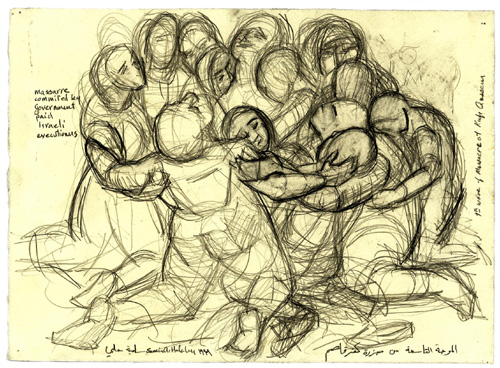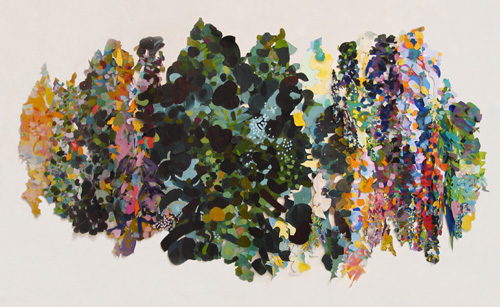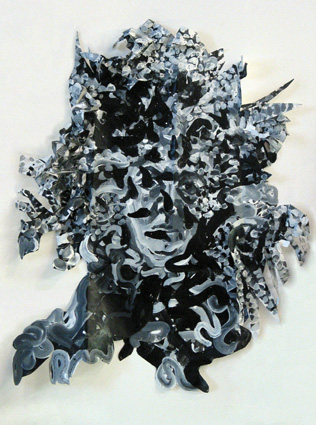
February 2006
The Art and Activism of Samia Halaby
Samia Halaby has been contributing to the development of international art for nearly fifty years. As one of the most established Palestinian-American artists, Halaby's work is aligned with the progression of the Palestinian art movement, which is renowned for its deep connection to Palestinian culture and political advocacy. Her dedication to the self-determination of formally colonized peoples has lead Halaby to explore creative venues that surpass the rigid boundaries of the mainstream art world.
While teaching art at American universities for seventeen years, Halaby frequently participated in solo and group exhibitions. After moving to New York in 1976 she became involved with underground art shows independent of commercial galleries. Since then she has continued to be a part of New York's ground-breaking art scene.

Samia Halaby's work, "The Kafre Qasem Massacre: The Ninth Wave of Killing," 1999
|
Halaby's involvement in the Palestinian art movement lead to the publication of her scholarly book, Liberation Art of Palestine in 2003, which culminated from years of interviews with forty-six of the most influential Palestinian artists. In Liberation Art of Palestine, Halaby provides the reader with a detailed history of contemporary Palestinian painting and sculpture through the thorough analysis of each artist's work and their contributions to the movement. In her publication, Halaby presents the ability of art to communicate the experiences of a people who are otherwise silenced.
In recent years, Halaby has also been active with humanitarian delegations to Palestine. Meanwhile, she continues to advocate the Palestinian cause through her art. For Halaby, "Palestine is full of epic subject matter. It seems that anywhere you look, any person you question, any door you knock at, reveals subject matter fitting for great art."

Samia Halaby's work, "Palestine from the Mediterranean Sea to the Jordan River,"
featured in the "Made in Palestine" exhibition |
The artistic process through which I Found Myself Growing Inside an Old Olive Tree and Palestine, from the Jordan to the Mediterranean Sea were created, displays the complexity of Halaby's creativity. Both pieces exhibit the innovative employment of light and structure with the use of black and white paint in vibrant abstractions that fascinate the viewer with the appearance of multiple dimensions and forms that seem to rise from the canvas.
With I Found Myself Growing Inside an Old Olive Tree, Halaby produced a self-portrait that communicates the intimate connection she feels towards her native Palestine. The piece is 36" x 24" and was created in response to an open invitation from the ArtCar Museum in Houston, Texas for artists to submit self-portraits to an exhibition titled, "Face". After spending a week in Al Ramah's olive orchards in Galilee painting its olive trees, Halaby was drawn to what she describes as, "the experience of these olives trees, and the way in which they share our fate as Palestinians." When she returned to her studio in New York and found the open invitation, she began to use acrylic and tyve to recount her experience in Galilee.

Samia Halaby's work, "I Found Myself Growing
Inside an Old Olive Tree," 2005 |
As the title suggests, Halaby's being is concentrated in both the physical and metaphorical elements of the olive tree. For many Palestinians, olive trees are life-giving ciphers that denote their tie to the homeland they continue to be expelled from. The use of a limited color palette suggests Halaby's return to an organic state of existence; the emphasis is on the unification of self with the foundation of her identity and origin of life.
In Palestine, from the Jordan to the Mediterranean Sea Halaby used multiple pieces of painted canvas and paper to create a map of color representing Palestine. The vast portrayal of Palestine is 7'3" x 13' and impacts the viewer with a layered assortment of brilliant color and intricate texture. In both size and effort, Halaby has described Palestine, from the Jordan to the Mediterranean Sea as a major piece in her production as a painter.
The sophistication of Halaby's use of abstraction lies in the reduction of the physical characteristics of Palestine into eye-catching color assemblages that inform the viewer of the significance of resonating environmental elements of a homeland that few can return to. When asked about the use of such colors Halaby affirmed, "I knew it was about parts of Palestine because various sections had specific geographic inspiration. Most obvious is the central dark green part, which is about the mountains of Ramallah and BirZeit at night. It captures the sensations of rows of rock on mountain sides, the shapes of rock, the color of fig leaves and their shapes, and a lot more that is difficult to quantify."
Halaby's use of cut paper and canvas intrinsically observes the Palestinian/Israeli conflict through courses of destruction and reformation. By painting and cutting the physical foundation of her map, Halaby acted as a sort of mediator on the destiny of her birthplace. Subsequent to devastation during the initial stages of the map, the remains were gathered and connected to create a vivid affirmation of natural beauty. Throughout the process, Halaby is able to voyage with her homeland from ruin to reconstruction. Palestine, from the Jordan to the Mediterranean Sea presents an optimistic future for millions of displaced Palestinians. "I have great optimism to the point of certainty, that Palestine will return to us and that we will build the sparkling society that is promised in out hearts," Halaby asserts.
The Kafre Qasem Massacre: The Ninth Wave of Killing is part of an eighteen-piece series of pencil drawings on paper that tell the horrifying stories of forty-nine people that were killed during the 1956 massacre of Kafre Qasem. Halaby created the drawings after visiting the Palestinian village during the mid 1990s. She describes The Ninth Wave of Killing as depicting the moment when, "sixteen women were shot over and over again until only one survived. The sole survivor was in the center of the big hug that the women created as they were being shot." Some called this event in the massacre "The Dance of Death" because when the shooting began the women came together and began to rotate slowly as bullets hit them.
The drawings employ a documentary style method reminiscent of Renaissance drawing. Halaby's forms are composed of vigorous sketches in a way that connotes a sense of continual movement. The use of such a technique not only records one of the most chilling moments of the massacre but also shows victims in the moments before death.
The image haunts the viewer, as the large body of victims is in continual rotation, struggling to protect the sole survivor. The composition of The Ninth Wave of Killing is simple yet the power of Halaby's documentation lies within the violent nature of drawing that aggressively makes up each figure. Despite the aggressive use of bold lines and vigorous sketching, Halaby's figures emanate with the fragility of defenseless victims caught in a cyclone of hostility. Humanity juxtaposed against cataclysmic violence reminds the viewer of the most devastating aspects of political conflict, the tragic loss of innocent lives.
Halaby's work and revolutionary spirit have inspired audiences, artists, activists and scholars. She continues to reinvent herself through her work and activism, each reinvention redefining the boundaries of art and political advocacy. For more information visit http://art.net/~samia/.
Contact us: Al-Awda Newspaper
(973) 954-2521
info@newjerseysolidarity.org
http://www.newjerseysolidarity.org
New Jersey Solidarity
344 Grove Street, Suite 131
Jersey City, NJ 07302
Our editorial collective is responsible for editing, laying out and developing this publication. We are open to new members who are in accord with the mission and principles of this newspaper.
Please contact us about your upcoming events and activities of interest to readers of this publication.
Please contact us for advertising rates and information, or for material on becoming a distributor.